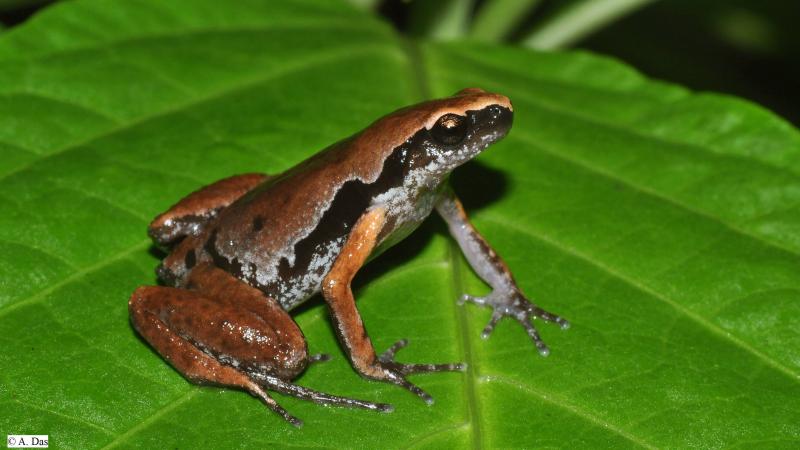
The monsoon is here; humming with the pouring rain are the croaks of frogs, for it is the season of love for most of them. But not for Micryletta aishani, the newest of the frogs discovered from the state of Assam. Unlike most frogs that breed during the monsoon, this elusive frog breeds before the onset of monsoon and then goes into hiding for the rest of the year.
The discovery is the result of six years of extensive fieldwork in the northeastern states of India by a team of researchers from the University of Delhi, Wildlife Institute of India, Indonesian Institute of Sciences and the University of Texas at Arlington, USA. They first found this frog in a highly disturbed secondary forest patch, very close to human settlements in the Cachar district of Assam, and later in the states of Tripura and Manipur.
“Our discovery shows that even fairly common frogs, usually found closer to human habitations, are still not documented properly. More extensive studies are required to scientifically identify and describe the northeastern frogs which are already facing extinction threats from various human activities”, says Dr Abhijit Das, a researcher at the Wildlife Institute of India and the lead author of the study. The study was published in the journal PeerJ and was partly funded by the Department of Science and Technology (DST), Science and Engineering Research Board (SERB) and Council for Scientific and Industrial Research (CSIR).
Micryletta aishani is named after the Sanskrit word ‘aishani’, meaning northeast, referring to this part of India where the frog was discovered. The researchers suggest using 'Northeast Indian paddy frog' as its common name. The frog belongs to the genus Micryletta, or narrow-mouthed paddy frogs, which are primarily widely distributed in Southeast Asia.
The new frog is reddish-brown in colour and measures about 2.2-2.8 cm in length. It has prominent dark streaks and ash-grey mottling on its lateral sides. They are seasonal and are active only during early monsoon.
“From our experience in the northeast in the last six years, we were not able to find these frogs during the monsoon period”, says Dr S.D. Biju from the University of Delhi, who is also an author of the study.
Not much is yet known about the behaviour or ecology of this frog, something that the researchers are finding out from the last three years. “Their breeding season lasts only for a short period, around the end of May, due to which we barely know anything about their behaviour. All we know is that they are early breeders, they come out for a short period of time and start calling, breed, and then vanish”, explains Dr Biju. These frogs haven’t been spotted during the other seasons.
The researchers compared the DNA samples of Micryletta aishani with all four known species of frogs from this genus found in Southeast and East Asia. They found that its physical features and DNA characteristics were different, resulting in the description of a new species. The DNA analyses also suggested that there could be more undescribed species of this genus in Southeast Asian countries like Laos, Cambodia, Thailand, and Vietnam.
“In the next couple of years, I’m sure that 4-5 more species in this genus can be described, mainly in the southeast Asian region”, says Dr Biju with confidence, since he was also a part of the team which recently rediscovered Micryletta inornata, another species from the same genus, in the islands of Sumatra after 125 years.
With many new species of frogs being described from different parts of the country and beyond, we are starting to fill the missing pieces in the puzzle that answers bigger questions on the biogeography and evolution of these ancient animals.
This article has been run past the researchers, whose work is covered, to ensure accuracy.





